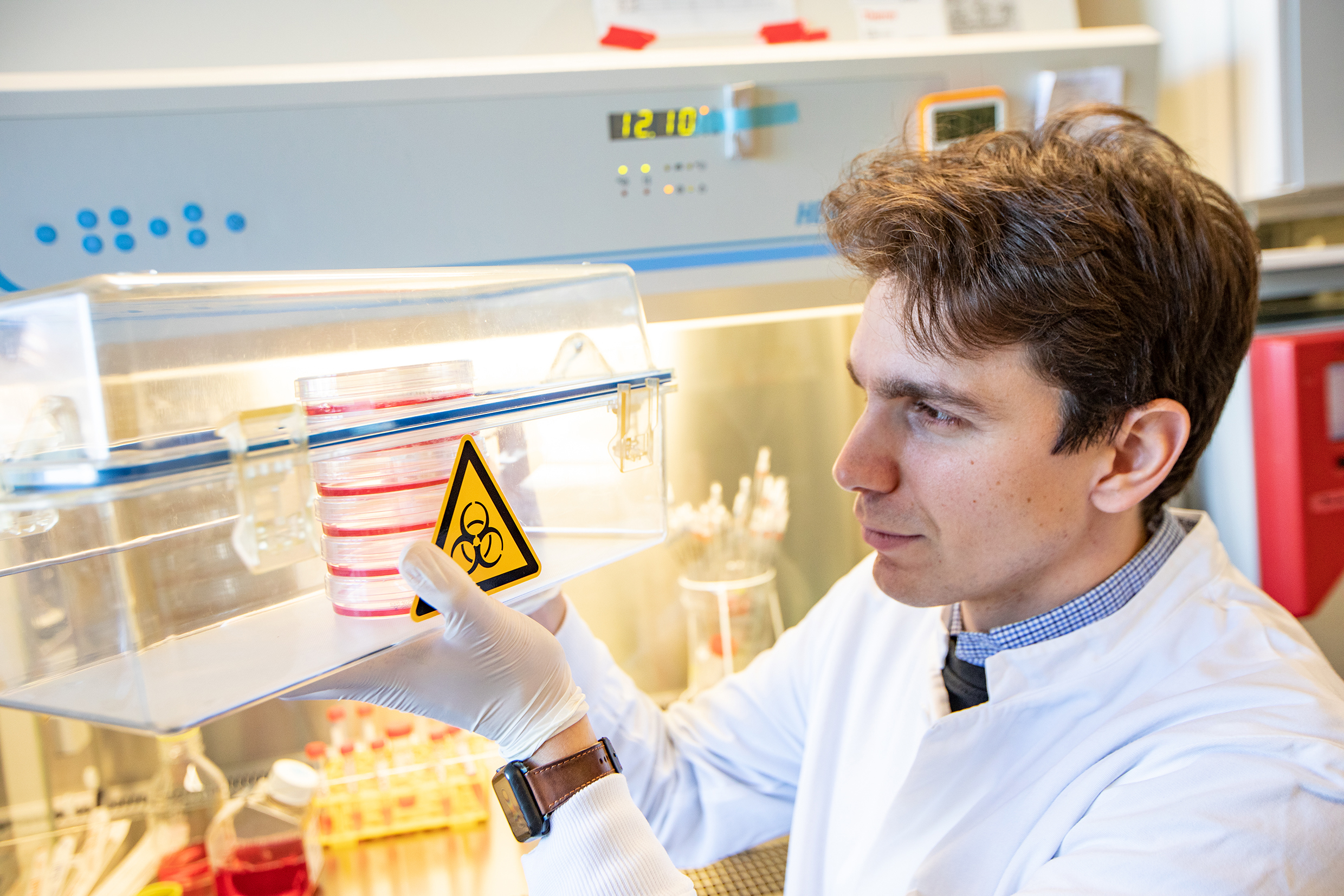Research project iGUARD receives follow-up funding for the development of RNA-based drugs

The young scientist Philippe Vollmer Barbosa with cell cultures for the production of the virus vectors that are to bring the drug into the lung cells as a gene taxi ; Copyright: Karin Kaiser / MHH
03.11.2022
Despite successful vaccine development, there are still no effective drugs for most viral diseases. This should change as soon as possible. With the project "iGUARD (integrated Guided Ultrafast Antiviral RNAi Drug development)", a research team led by Professor Dr. Axel Schambach, head of the Institute for Experimental Haematology at the Hannover Medical School (MHH), is developing RNA-based drugs to combat viral diseases in cooperation with the Fraunhofer Institute for Toxicology and Experimental Medicine ITEM, using a natural mechanism of our body. The drugs should be able to adapt particularly quickly to different viruses and thus provide protection against emerging infectious diseases. The project has been supported by the Federal Agency for Leap Innovations (SPRIND) for one year and is now receiving follow-up funding of 1.5 million euros for another year.
Systematically blocking virus replication
The iGUARD research team is focusing on the parainfluenza virus, which primarily attacks the lower respiratory tract in children and people with weakened immune systems. It triggers flu-like symptoms, but its course can also be very severe. The aim is to prevent the virus from multiplying and spreading in the body with the help of so-called RNA interference (RNAi). RNAi is a natural mechanism in our cells for the targeted silencing of genes. In the process, the so-called messenger RNAs (mRNAs) are cleaved and the building instructions for proteins contained in them are destroyed. However, the RNAi system can also be used to block foreign RNAs. In the case of a viral infection, the body forms short RNA fragments that bind like a Lego brick to the right place on the viral RNA, thus making it unreadable and initiating its degradation. The result: the genetic blueprint packed in it is not implemented and virus replication is blocked. "In the meantime, we have developed suitable RNAi building blocks that specifically paralyse different sections of the parainfluenza virus genome that the virus needs for its reproduction," says Professor Schambach.
Efficacy of RNAi candidates successfully tested in lung tissue
The RNAi technology uses molecular methods to attack the Achilles' heel of the viruses, so to speak. With the help of artificial intelligence, the so-called in-silico design, the research team has primarily searched for "conserved" regions from gene databases. These are indispensable for the virus and are therefore unlikely to change, so that no resistance can develop. Such a search normally takes months or years. Thanks to a self-constructed development pipeline, this process could be shortened to a few weeks. "We have successfully tested the efficacy of our RNAi candidates on human lung tissue sections as well as in 3D cell cultures from human lung epithelium," explains Professor Dr. Armin Braun, Head of Preclinical Pharmacology and Toxicology at Fraunhofer ITEM. "There they were able to suppress the parainfluenza virus by 95 percent. The immune system does the rest."
Method is also suitable for other virus types
In the next step, the efficiency and safety of the RNAi candidates will be tested in animal models. In addition, the RNA therapeutic agent is not to be administered with a syringe or as a tablet, but is to be inhaled directly into the lower respiratory tract. Corresponding transfer procedures to bring the therapeutic RNA directly into the target cell in the lung affected by the virus have already been developed. "The long-term goal is, on the one hand, to use our iGUARD platform to construct corresponding therapeutics for other known viral diseases and, on the other hand, to quickly adapt the active substances to unknown, newly emerging virus types," Professor Schambach emphasises.
The iGUARD project is a cooperation between the MHH Institute for Experimental Haematology (Professor Dr. Dr. Axel Schambach, Philippe Vollmer Barbosa), the MHH Clinic for Haematology, Haemostaseology, Oncology and Stem Cell Transplantation (Dr. Dr. Adrian Schwarzer) and the Preclinical Pharmacology and Toxicology at Fraunhofer ITEM (Professor Dr. Armin Braun, Philippe Vollmer Barbosa). After one year, the team can apply for the third funding round.
SERVICE:
For further information, please contact Professor Dr. Dr. Axel Schambach, schambach.axel@mh-hannover.de, telephone (0511) 532-5170.